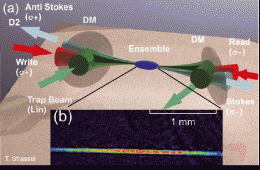October 7, 2008 feature
Long-Lasting Quantum Memory Leads to Long-Distance Quantum Communication

(PhysOrg.com) -- Physicists have taken a step closer to realizing long-distance quantum communication, in which a quantum state is transferred from one location to another by becoming entangled with a traveling photon.
The basis for quantum communication is the ability to entangle two photons, A and B, where one photon, B, is sent down a transmission channel. There is also a third photon, C, which is entangled to a quantum state but not to the other two photons. A quantum state may be represented by a group of atoms that shares a superposition between two ground states (in superposition, both ground states exist simultaneously, and there is a certain probability that the atoms are in one ground state or the other).
When physicists perform entanglement swapping by making a Bell state measurement on photons A and C, photon B also becomes immediately entangled to the quantum state, even though it has already traveled down the transmission channel.
The site where the sent photon becomes entangled with the quantum state is called a quantum repeater. Quantum repeaters, which occur throughout the transmission channel, can generate and store entanglement in order to boost the signal, with the aim of getting the entangled state to reach the other end. Entanglement can be stored by some sort of quantum memory device until, ultimately, the quantum state is “read” by being converted into another photon.
The key is that the quantum state should stay entangled with the sent photon for as long as possible, in order to maintain the quantum correlation throughout the transmission channel. Without a quantum memory, there is a small probability that quantum information can be transmitted over large distances, but the probability is exponentially dependent on the transmission length. With quantum memory, the transmission probability is only polynomially dependent on the length, greatly reducing the waiting time for a successful transmission.
Physicists are currently working to improve the storage times of quantum memory devices. Recently, a team of scientists from the University of Heidelberg in Germany, the University of Science and Technology of China in Heifei, China, and the Atominstitute der Österreichischen Universitäten in Vienna, Austria, has demonstrated a new way to extend the storage time of quantum memory devices. For the first time, the scientists successfully used an optical trap to confine a group of atoms, in which the quantum state is stored. The scientists predict that the method could greatly exceed previous storage times that are on the order of microseconds.
“Our work opens up new avenues for extending the coherence time of a quantum memory towards the seconds regime,” co-author Chih-Sung Chuu of the University of Heidelberg told PhysOrg.com. He added that a storage time of a few seconds could result in a communication distance of a few thousand miles.
Most quantum memory devices reported to date use magneto-optical traps, rather than optical traps, to confine groups of atoms. However, the magnetic field limits the storage time by causing the atoms’ ground state to broaden. The broadening lingers even when the magnetic field is temporarily turned off during storage, and, without the magnetic field’s confinement, the atoms begin to diffuse after a few hundred microseconds. With this limited storage time, quantum communication cannot reach very long distances.
By using an optical trap instead, the scientists could eliminate the negative effects of the magnetic field on storage time. The optical trap is formed by a tightly focused laser beam, which can trap atoms at a density of one trillion atoms per cubic centimeter. Then, a right-circularly polarized “write” beam of about 100,000 photons illuminates the group of atoms. Later, a left-circularly polarized “read” beam converts the quantum state of the atoms into a photon.
“The ‘write’ beam probabilistically generates a quantum state in the atoms by interacting with them,” Chuu explained. “The ‘read’ beam is used to convert the quantum state into a photon, which can be detected by a single-photon detector.”
In their demonstration, the scientists achieved storage times of 60 microseconds, but they explain that this is currently limited by the high temperature of the experiment. Cooling the atomic ensemble to a lower temperature (submicro-Kelvin, or very near absolute zero) could limit the thermal motion of the atoms, and extend the storage time. With cooler temperatures and by using an optical lattice for additional confinement, the physicists expect to achieve a storage time of several seconds.
By increasing the storage time of a quantum memory device, the scientists have taken another step toward realizing long-distance quantum communication, which could be used to build quantum computers, among other innovations. Quantum computers could be extremely quick at solving certain problems, such as factoring, which would make them useful for applications that require large amounts of computing power.
More information: Chuu, Chih-Sung; Strassel, Thorsten; Zhao, Bo; Koch, Markus; Chen, Yu-Ao; Chen, Shuai; Yuan, Zhen-Sheng; Schmiedmayer, Jörg; and Pan, Jian-Wei. “Quantum Memory with Optically Trapped Atoms.” Physical Review Letters 101, 120501 (2008).
Copyright 2008 PhysOrg.com.
All rights reserved. This material may not be published, broadcast, rewritten or redistributed in whole or part without the express written permission of PhysOrg.com.




















